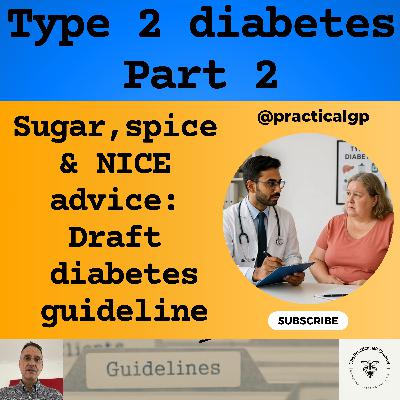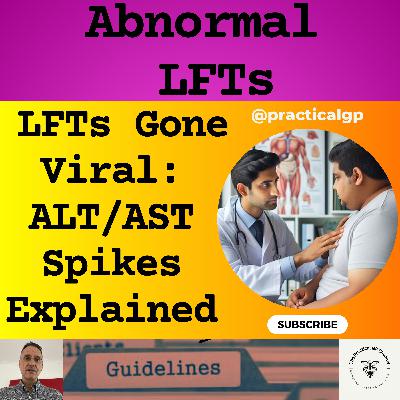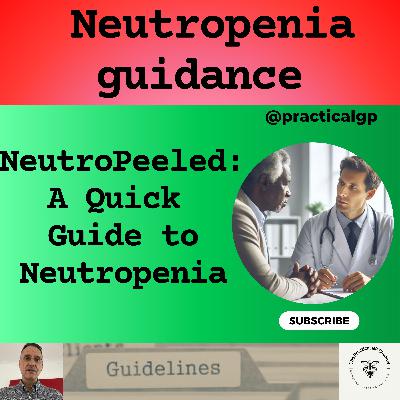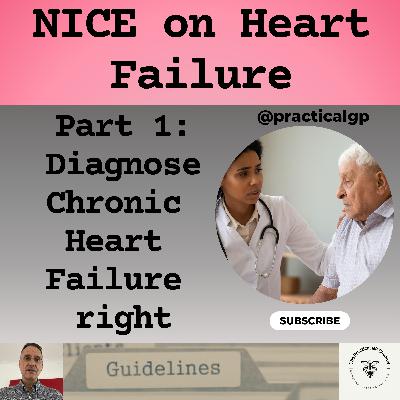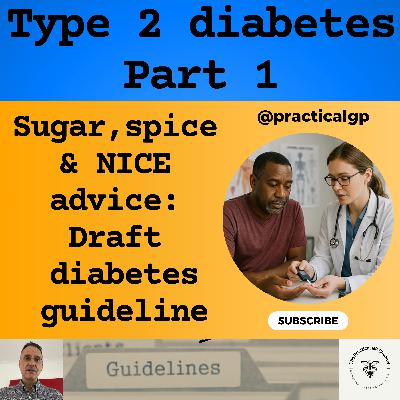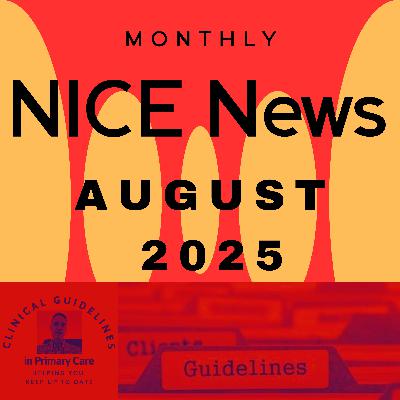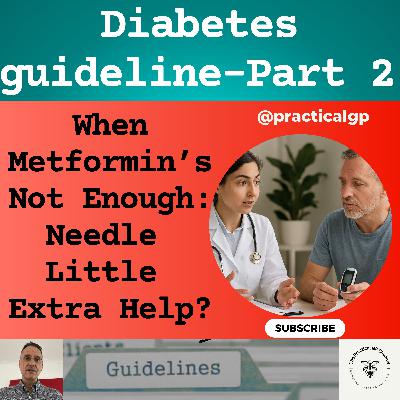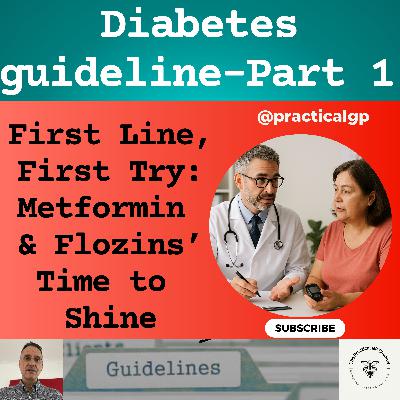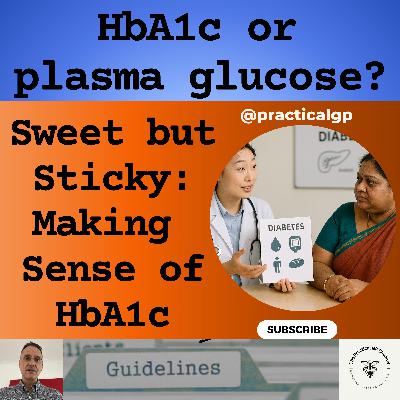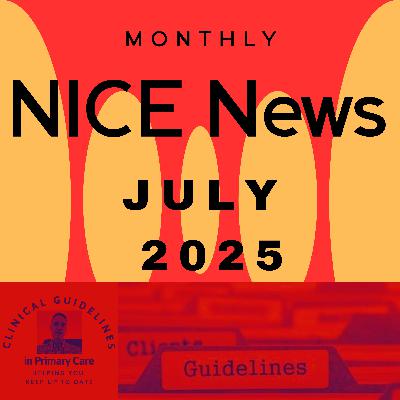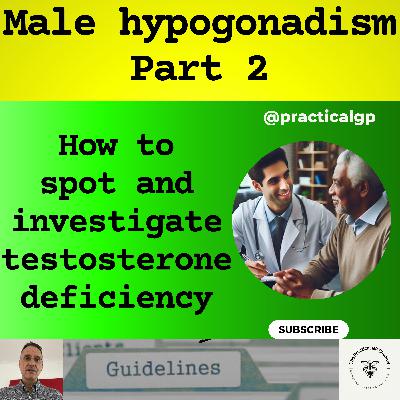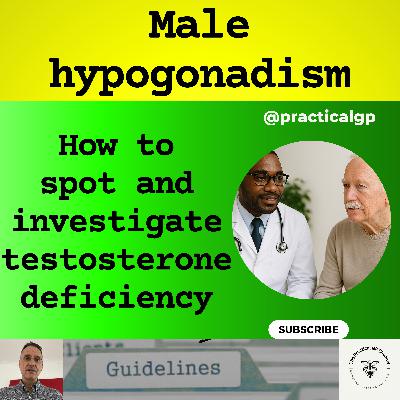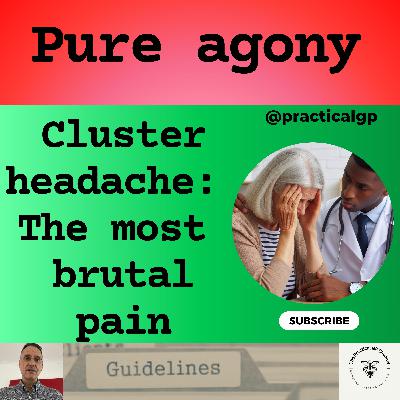Podcast - Sugar, Spice & NICE Advice: The Draft NICE Guideline on Type 2 Diabetes- Part 2
Description
The video version of this podcast can be found here:
· https://youtu.be/M0s2Vvlia70
This episode makes reference to guidelines produced by the "National Institute for Health and Care Excellence" in the UK, also referred to as "NICE". The content on this channel reflects my professional interpretation/summary of the guidance and I am in no way affiliated with, employed by or funded/sponsored by NICE.
NICE stands for "National Institute for Health and Care Excellence" and is an independent organization within the UK healthcare system that produces evidence-based guidelines and recommendations to help healthcare professionals deliver the best possible care to patients, particularly within the NHS (National Health Service) by assessing new health technologies and treatments and determining their cost-effectiveness; essentially guiding best practices for patient care across the country.
My name is Fernando Florido and I am a General Practitioner in the United Kingdom. In this episode I go through the draft NICE guideline on type 2 diabetes, which is open for public consultation until October 2025, and the final guidance being due in February 2026. Today’s episode is based on the NICE visual summary and the link to it is below.
The visual summary includes general guidance for all patient, and specific guidance for 7 different group of patients. In today’s episode we will cover three clinical groups and the remaining groups will be done in next week’s episode.
I am not giving medical advice; this video is intended for health care professionals, it is only my summary and my interpretation of the guidelines and you must use your clinical judgement.
Disclaimer:
The Video Content on this channel is for educational purposes and not intended to be a substitute for professional medical advice, diagnosis, or treatment. Always seek the advice of your physician or other qualified health provider with any questions you may have regarding a medical condition. Never disregard professional medical advice or delay in seeking it because of something you have read or seen on this YouTube channel. The statements made throughout this video are not to be used or relied on to diagnose, treat, cure or prevent health conditions.
In addition, transmission of this Content is not intended to create, and receipt by you does not constitute, a physician-patient relationship with Dr Fernando Florido, his employees, agents, independent contractors, or anyone acting on behalf of Dr Fernando Florido.
Intro / outro music: Track: Halfway Through — Broke In Summer [Audio Library Release]
- Music provided by Audio Library Plus
- Watch: https://youtu.be/aBGk6aJM3IU
- Free Download / Stream: https://alplus.io/halfway-through
There is a podcast version of this and other videos that you can access here:
Primary Care guidelines podcast:
· Redcircle: https://redcircle.com/shows/primary-care-guidelines
· Spotify: https://open.spotify.com/show/5BmqS0Ol16oQ7Kr1WYzupK
· Apple podcasts: https://podcasts.apple.com/gb/podcast/primary-care-guidelines/id1608821148
There is a YouTube version of this and other videos that you can access here:
- The Practical GP YouTube Channel:
https://youtube.com/@practicalgp?si=ecJGF5QCuMLQ6hrk
The NICE announcement on Type 2 diabetes management can be found here:
· https://www.nice.org.uk/news/articles/biggest-shake-up-in-type-2-diabetes-care-in-a-decade-announced
The NICE draft guideline on Type 2 diabetes can be found here:
· https://www.nice.org.uk/guidance/gid-ng10336/documents/450
The visual summary of the NICE draft guideline on type 2 diabetes can be found here:
· https://www.nice.org.uk/guidance/GID-NG10336/documents/draft-guideline-2
Transcript
If you are listening to this podcast on YouTube, for a better experience, switch to the video version. The link is in the top right corner of the video and in the episode description.
Hello and welcome! I’m Fernando, a GP in the UK. In today’s episode, we are going to review the draft NICE guideline on type 2 diabetes, focusing on the main changes as applied to 7 specific groups of patients.
Right, let’s jump into it.
And, as you know, the draft guideline is open for consultation until October, and the final guidance is due in February 2026, so let’s not forget that it is only a draft, and we should not be making clinical decisions based on it yet.
Today’s episode is based on the visual summary created by NICE and the link to it is in the episode description.
The visual summary includes specific guidance for 7 different group of patients. In today’s episode we will cover three of the groups and we will finish the other groups in next week’s episode.
There are 7 groups:
1. First, the group of patients with no relevant comorbidities, then
2. Obesity
3. Frailty
4. CKD
5. Heart failure
6. Atherosclerotic cardiovascular disease and
7. Early onset type 2 diabetes
So let’s start with the no relevant comorbidities group.
For adults with type 2 diabetes and no major comorbidities, the draft recommends metformin plus an SGLT-2 inhibitor from the outset. If metformin is contraindicated or not tolerated, then an SGLT-2 inhibitor alone should be offered. If further glycaemic lowering is required, the next step is to add a DPP-4 inhibitor and if this is not effective or tolerated, we can try a sulfonylurea, pioglitazone, or insulin.
This is very different from the previous guidance, which began with metformin monotherapy, and only added other agents if HbA1c targets were not met. SGLT-2 inhibitors and GLP-1 receptor agonists were generally reserved for people with established cardiovascular or renal disease, or later in the treatment pathway. The draft changes our thinking on everything by recommending dual therapy right at diagnosis for all, even in people without comorbidities.
Why is NICE changing the advice?
As we have already explained, evidence shows that SGLT-2 inhibitors consistently reduce heart failure admissions, slow CKD progression, and lower cardiovascular death. Trials have showed these effects in people without established CVD they are now recommended for all, not just for the high-risk subgroups.
What this means in practice is that now:
- The default first-line choice is now metformin + SGLT-2 inhibitor, not metformin alone.
- More people will start dual therapy earlier, meaning that we will need to discuss SGLT-2 inhibitor side effects like the risk of genital infections, volume depletion, sick-day rules, and renal monitoring from the start.
- In those who can’t tolerate metformin, an SGLT-2 inhibitor alone is acceptable. We also need to consider the fact that SGLT2 inhibitors will now be prescribed long term unless there are specific reasons to stop them.
- And, if further glucose control is needed, add-ons agents remain available but they now come after the SGLT-2 inhibitor, not before.
The next group is the obesity group:
For people with type 2 diabetes who also have obesity, the draft recommends also starting with metformin plus an SGLT-2 inhibitor. However, if further treatment is needed to reach glycaemic targets, we will add a GLP-1 receptor agonist if initial therapy started 3 months ago or more. This will usually mean adding subcutaneous semaglutide, provided there are no concerns about frailty and they have preserved ejection fraction (i.e., heart function is acceptable). If metformin is contraindicated or not tolerated, the pathway is to offer an SGLT-2 inhibitor plus semaglutide.
We are again reminded that GLP1 receptor agonists and DPP-4 inhibitors should not be combined. Therefore, if the patient is on a GLP-1 receptor agonist and further glycaemic control is needed, the next add-on therapies are sulfonylurea, pioglitazone, or insulin depending on the case. However, if a GLP-1 receptor agonist is contraindicated, not tolerated, or not appropriate, we will add a DPP-4 inhibitor first before considering other agents such as a sulfonylurea, pioglitazone, or insulin, as all of these can lead to weight gain.
And let’s remember that previously, people with obesity were more likely to have a stepwise approach: metformin first, then add other agents and then move to GLP-1 RAs only if at last resort and if specific BMI thresholds were cross

